Games controller
Burgess , et al. Ja
U.S. patent number 10,188,940 [Application Number 15/040,000] was granted by the patent office on 2019-01-29 for games controller. This patent grant is currently assigned to Ironburg Inventions Ltd.. The grantee listed for this patent is Ironburg Inventions Ltd.. Invention is credited to Simon Burgess, Duncan Ironmonger.
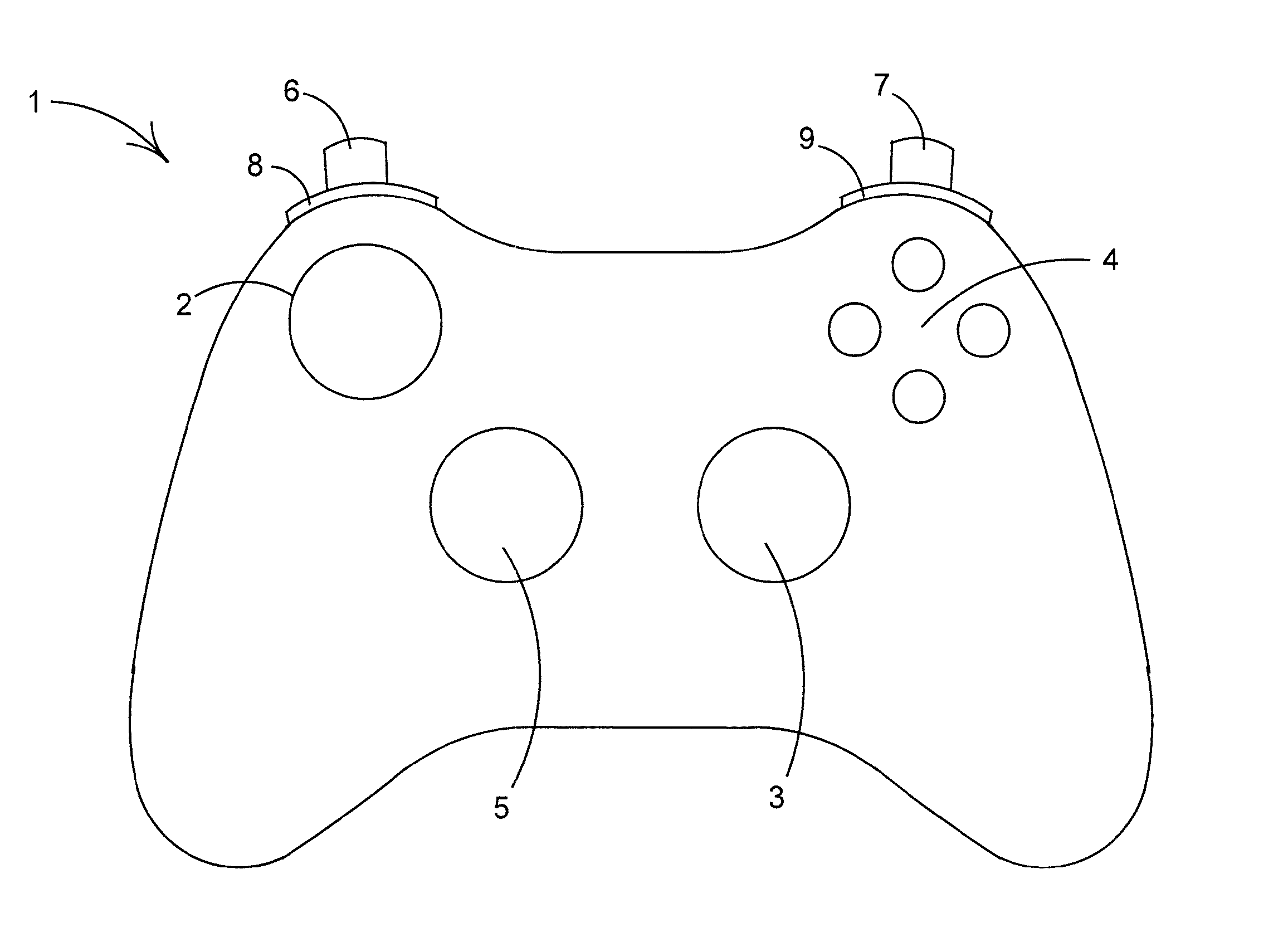
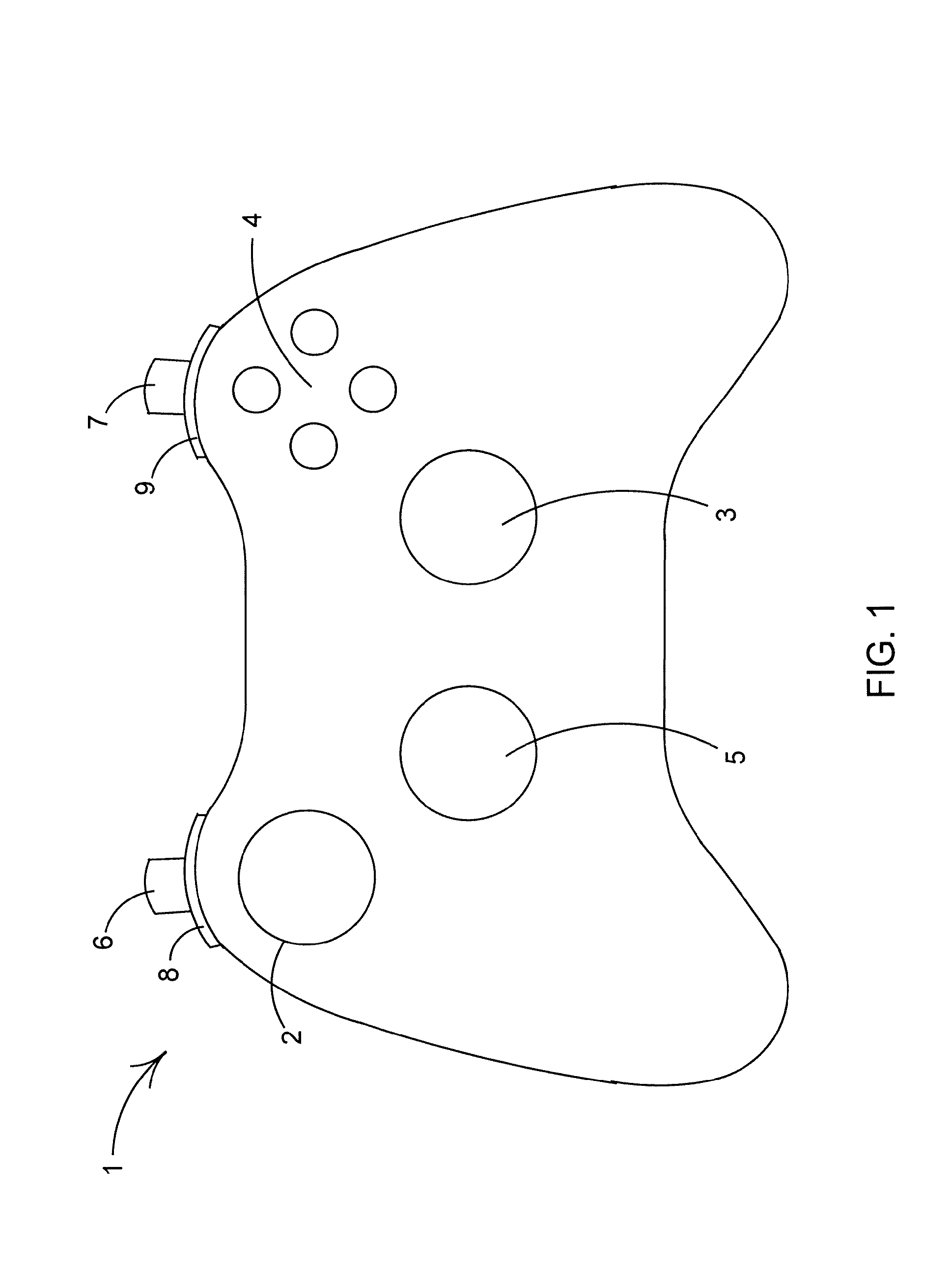




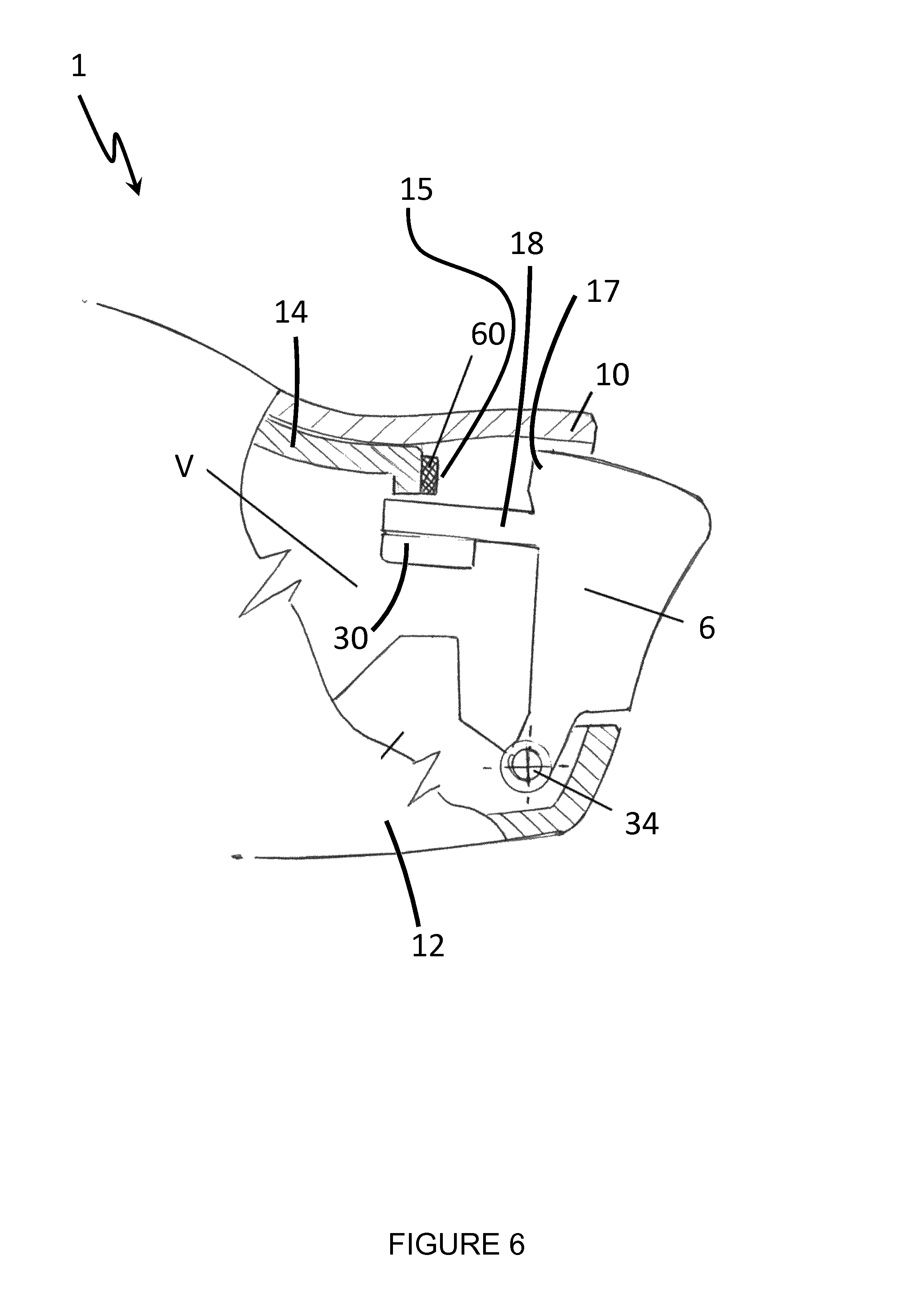
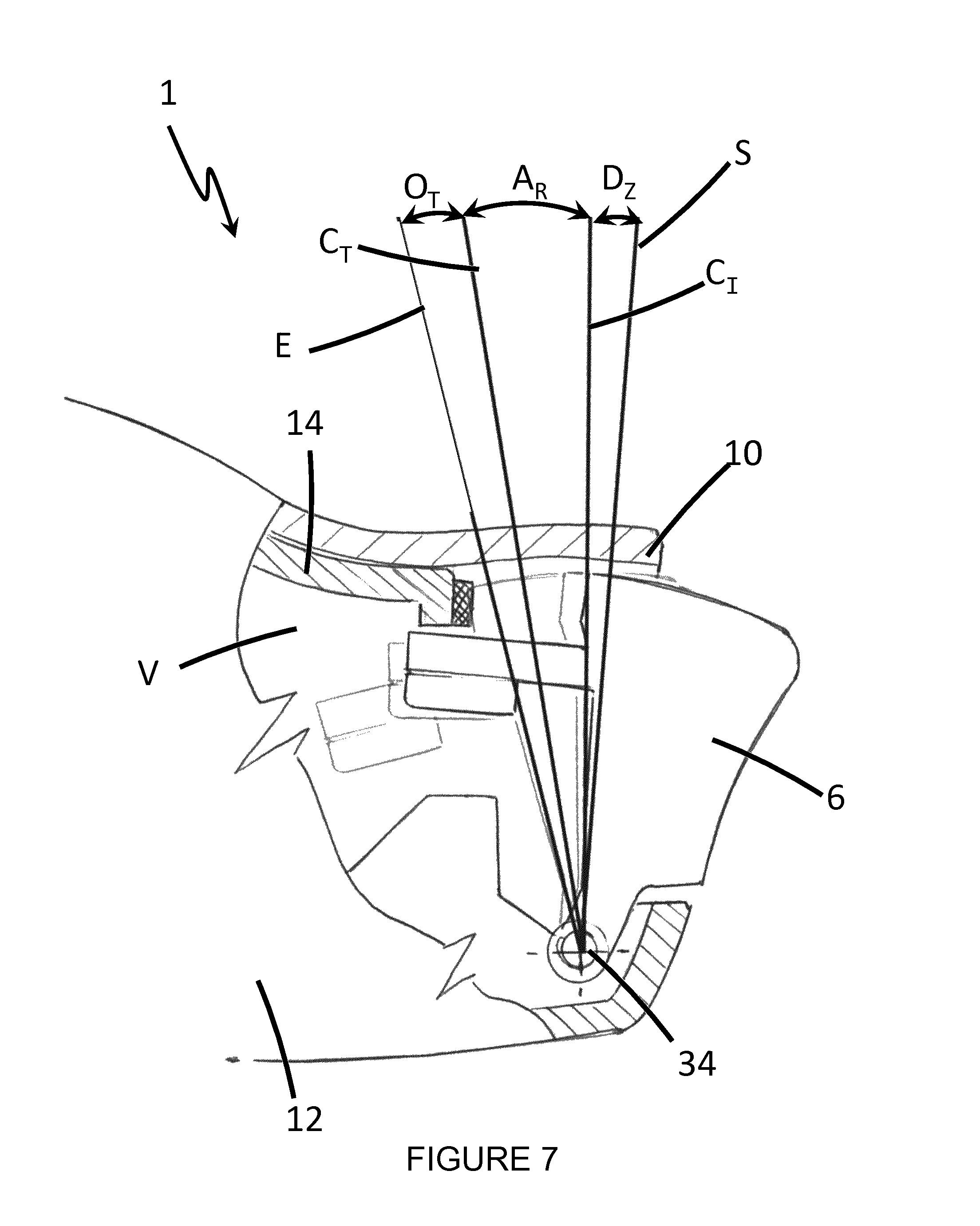
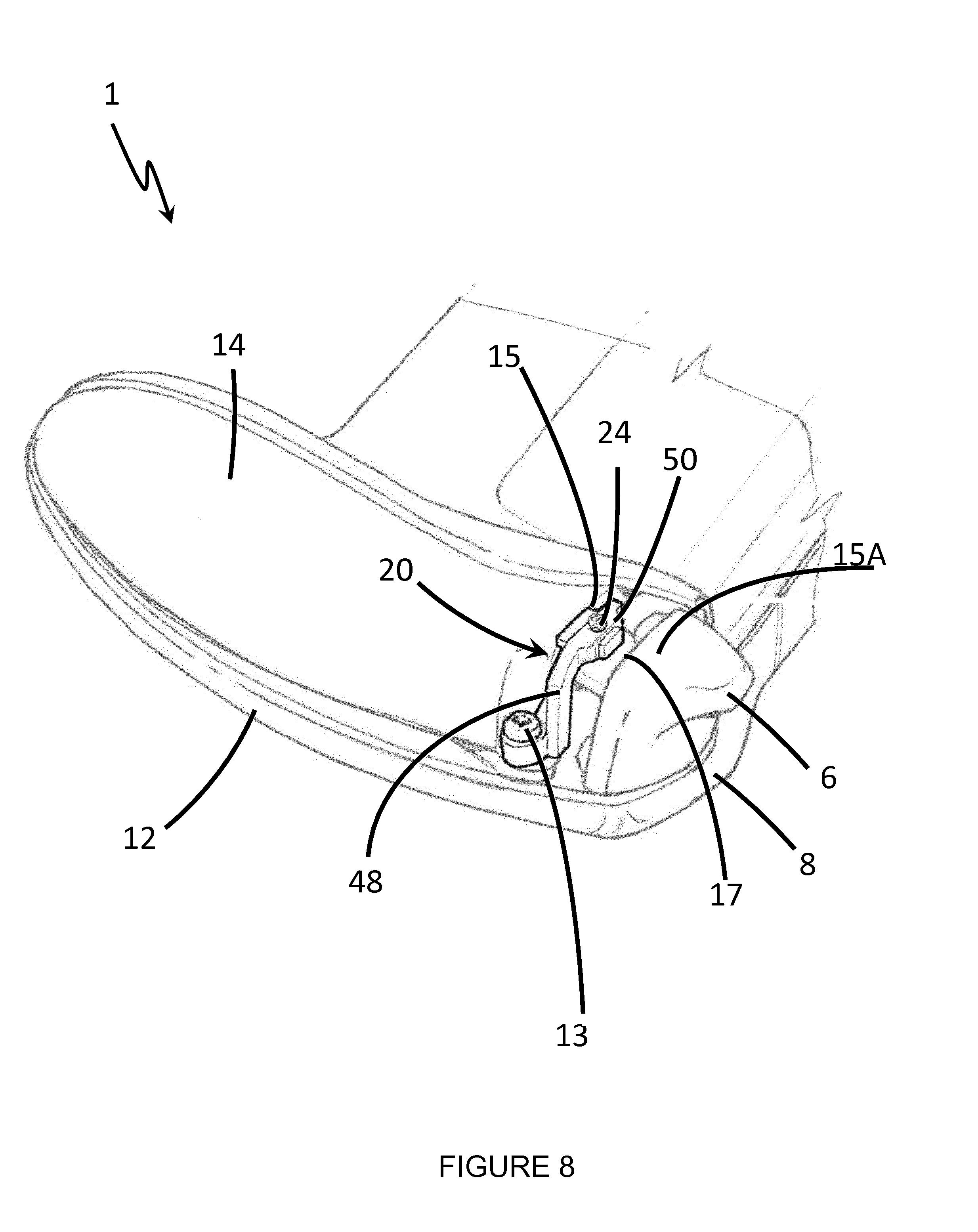

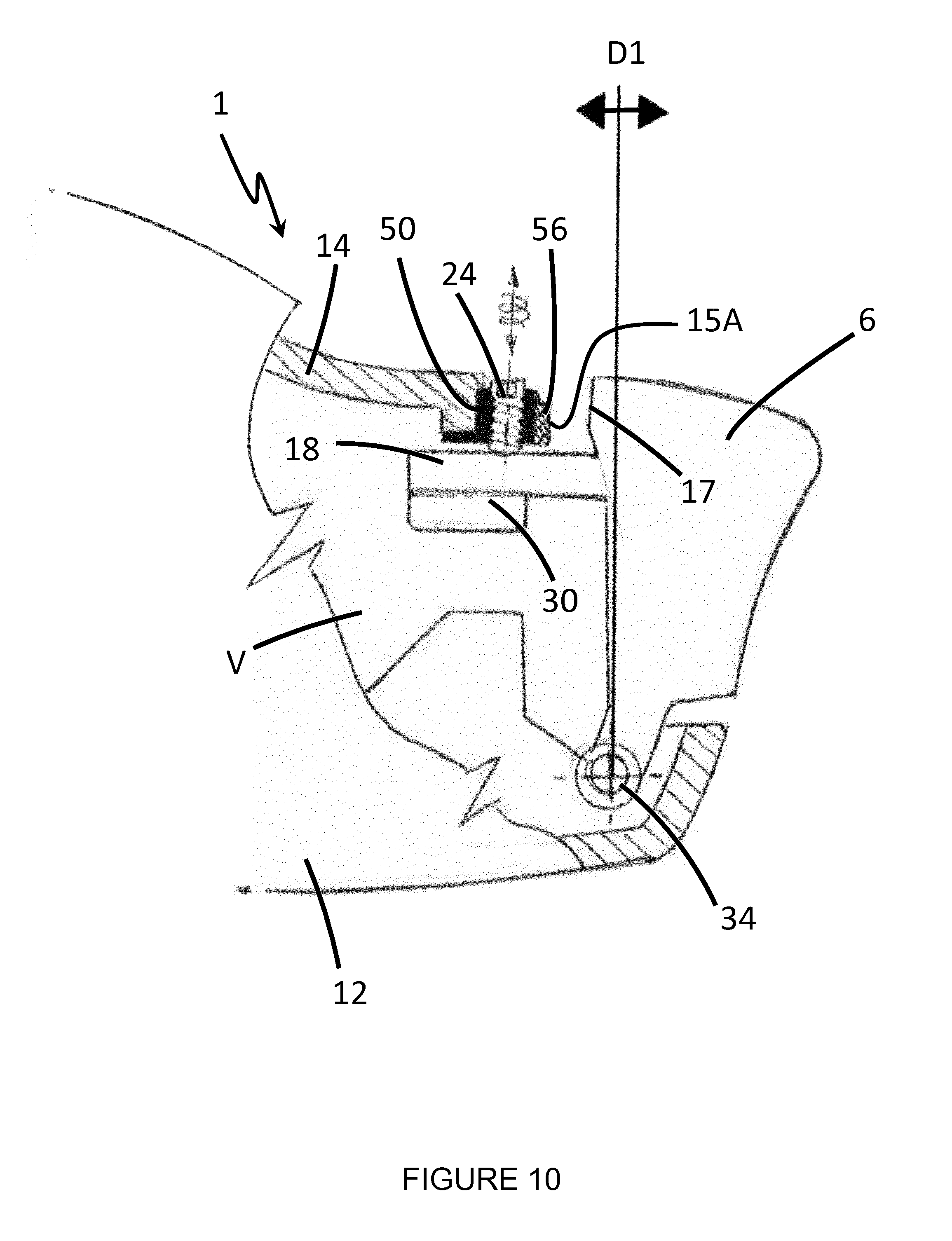

View All Diagrams
| United States Patent | 10,188,940 |
| Burgess , et al. | January 29, 2019 |
Games controller
Abstract
A game controller for controlling electronic games comprising a controller chassis and an actuator system including: an actuator body pivotally mounted to the controller chassis; a strike plate coupled to the actuator body; a trigger adjustment system having an arm; and an actuator adjustment control screw received in a screw thread disposed within said arm. A portion of the actuator adjustment control screw may engage with a portion of the strike plate and said portion of the actuator adjustment control screw creates an end stop to limit movement of the actuator body.
| Inventors: | Burgess; Simon (Cossington, GB), Ironmonger; Duncan (Atlanta, GA) | ||||||||||
|---|---|---|---|---|---|---|---|---|---|---|---|
| Applicant: |
|
||||||||||
| Assignee: | Ironburg Inventions Ltd.
(Wincanton, GB) |
||||||||||
| Family ID: | 51982586 | ||||||||||
| Appl. No.: | 15/040,000 | ||||||||||
| Filed: | November 27, 2014 | ||||||||||
| PCT Filed: | November 27, 2014 | ||||||||||
| PCT No.: | PCT/EP2014/075861 | ||||||||||
| 371(c)(1),(2),(4) Date: | May 27, 2016 | ||||||||||
| PCT Pub. No.: | WO2015/078994 | ||||||||||
| PCT Pub. Date: | June 04, 2015 |
Prior Publication Data
| Document Identifier | Publication Date | |
|---|---|---|
| US 20170157509 A1 | Jun 8, 2017 | |
Related U.S. Patent Documents
| Application Number | Filing Date | Patent Number | Issue Date | ||
|---|---|---|---|---|---|
| 61910260 | Nov 29, 2013 | ||||
| Current U.S. Class: | 1/1 |
| Current CPC Class: | A63F 13/22 (20140902); A63F 13/24 (20140902); A63F 2300/1018 (20130101); A63F 2300/1043 (20130101) |
| Current International Class: | A63F 13/22 (20140101); A63F 13/24 (20140101) |
References Cited [Referenced By]
U.S. Patent Documents
| 4032728 | June 1977 | Oelsch |
| 5430262 | July 1995 | Matsui et al. |
| 5451053 | September 1995 | Garrido |
| 5773769 | June 1998 | Raymond |
| 5841372 | November 1998 | Matsumoto |
| 5874906 | February 1999 | Willner et al. |
| 5989123 | November 1999 | Tosaki et al. |
| 6203432 | March 2001 | Roberts et al. |
| 6251015 | June 2001 | Caprai |
| 6512511 | January 2003 | Willner et al. |
| 6752719 | June 2004 | Himoto et al. |
| 6760013 | July 2004 | Willner et al. |
| 7510477 | March 2009 | Argentar |
| 7758424 | July 2010 | Riggs et al. |
| 7859514 | December 2010 | Park |
| 8641525 | February 2014 | Burgess et al. |
| 8777620 | July 2014 | Baxter |
| 9089770 | July 2015 | Burgess et al. |
| 9804691 | October 2017 | Strahle et al. |
| 2001/0003713 | June 2001 | Willner et al. |
| 2001/0025778 | October 2001 | Ono |
| 2002/0052237 | May 2002 | Magill |
| 2002/0128064 | September 2002 | Sobota |
| 2003/0067111 | April 2003 | Swan et al. |
| 2004/0259059 | December 2004 | Aoki |
| 2005/0083297 | April 2005 | Duncan |
| 2005/0255915 | November 2005 | Riggs et al. |
| 2005/0255918 | November 2005 | Riggs et al. |
| 2006/0025217 | February 2006 | Hussaini et al. |
| 2006/0116204 | June 2006 | Chen et al. |
| 2008/0261695 | October 2008 | Coe |
| 2009/0088250 | April 2009 | Carlson |
| 2009/0258705 | October 2009 | Guinchard |
| 2010/0073283 | March 2010 | Enright |
| 2010/0267454 | October 2010 | Navid |
| 2010/0304865 | December 2010 | Picunko |
| 2011/0256930 | October 2011 | Jaouen |
| 2011/0281649 | November 2011 | Jaouen |
| 2012/0088582 | April 2012 | Wu et al. |
| 2012/0142418 | June 2012 | Muramatsu |
| 2012/0142419 | June 2012 | Muramatsu |
| 2012/0299244 | November 2012 | Rice et al. |
| 2012/0322553 | December 2012 | Burgess et al. |
| 2012/0322555 | December 2012 | Burgess |
| 2013/0147610 | June 2013 | Grant et al. |
| 2013/0150155 | June 2013 | Barney et al. |
| 2013/0196770 | August 2013 | Barney et al. |
| 2014/0274397 | September 2014 | Sebastian |
| 2015/0234479 | August 2015 | Schantz et al. |
| 2015/0238855 | August 2015 | Uy et al. |
| 2016/0082349 | March 2016 | Burgess et al. |
| 2016/0193529 | July 2016 | Burgess et al. |
| 2016/0346682 | December 2016 | Burgess et al. |
| 2017/0001107 | January 2017 | Burgess et al. |
| 2017/0001108 | January 2017 | Burgess et al. |
| 2017/0087456 | March 2017 | Burgess et al. |
| 2017/0151494 | June 2017 | Ironmonger et al. |
| 2017/0157509 | June 2017 | Burgess et al. |
| 1852162 | Nov 2007 | EP | |||
| 2 479 636 | Jul 2012 | EP | |||
| 2 698 185 | Feb 2015 | EP | |||
| 2 244 546 | Dec 1991 | GB | |||
| 2 481 633 | Jan 2012 | GB | |||
| H1020951 | Jan 1998 | JP | |||
| WO 03/046822 | Jun 2003 | WO | |||
| WO 2008/131249 | Oct 2008 | WO | |||
| WO2014/187923 | Nov 2014 | WO | |||
| WO2015/004261 | Jan 2015 | WO | |||
| WO2015/110553 | Jul 2015 | WO | |||
Other References
|
European Patent Office, Communication pursuant to Article 94(3) EPC, Application. No. 14 802 929.1 (dated Jul. 21, 2017). cited by applicant . International Search Report, PCT/EP2014/075851 (dated 2015). cited by applicant . International Search Report, PCT/EP2014/075861 (dated 2015). cited by applicant . International Search Report, PCT/EP2014/060587 (dated 2014). cited by applicant . International Search Report, PCT/EP2015/058096 (dated 2015). cited by applicant . Written Opinion of the International Searching Authority, PCT/EP2015/058096 (dated 2015). cited by applicant . Burns, "Review: Scuf Xbox 360 Controller," Xboxer360.com (2010). cited by applicant . Combined Search and Examination Report, GB1011078.1 (dated 2011). cited by applicant . "Rapid Fire Mod for Wireless Xbox 360 Controller," forum on xbox-scene.com, (2008). cited by applicant . "Thrustmaster USB game controller roundup," dansdata.com/tmsticks.htm (2002). cited by applicant . Coles, Olin, "Thrustmaster Run-N-Drive PC/PS3 Wireless Gamepad" BenchmarkReviews.com (2009). cited by applicant . Office Action, U.S. Appl. No. 14/832,211 (dated 2015). cited by applicant . Office Action, U.S. Appl. No. 14/736,771 (dated 2015). cited by applicant . Office Action, U.S. Appl. No. 14/805,597 (dated 2015). cited by applicant . Office Action, U.S. Appl. No. 14/805,641 (dated 2015). cited by applicant . Corrected Petition for Inter Partes Review of U.S. Pat. No. 9,089,770, Under 37 C.F.R. .sctn. 42.100, filed by Valve Corporation, Case IPR2016-00949 (2016). cited by applicant . Corrected Petition for Inter Partes Review of U.S. Pat. No. 8,641,525, Under 37 C.F.R. .sctn. 42.100, filed by Valve Corporation, Case IPR2016-00948 (2016). cited by applicant . Xbox 360 Wireless Controller Tour, published on May 13, 2005 at http://www.ign.com/articles/2005/05/13/xbox-360-wireless-controller-tour. cited by applicant. |
Primary Examiner: Deodhar; Omkar
Attorney, Agent or Firm: Walters & Wasylyna LLC
Claims
The invention claimed is:
1. An apparatus for supplying user inputs to a computer program for controlling the computer program, the apparatus comprising an outer case, at least one depressible trigger mechanism, and a mechanism for manual adjustment of a range of motion of the at least one trigger mechanism, the mechanism being disposed within an internal volume defined by the outer case of the apparatus.
2. An apparatus for supplying user inputs to a computer program for controlling the computer program, the apparatus comprising an outer case, at least one depressible trigger mechanism, and a first mechanism for adjusting a first end stop position of a range of motion of the at least one depressible trigger mechanism, the first mechanism being disposed within an internal volume defined by the outer case of the apparatus.
3. The apparatus of claim 2 further comprising a second mechanism which provides for manual adjustment of a second end stop position of the range of motion of the at least one depressible trigger mechanism, the second mechanism being disposed within the internal volume defined by the outer case of the apparatus.
4. A game controller for controlling electronic games, including a housing, at least one depressible trigger at least in part exposed relative to the housing, said at least one depressible trigger being in operational association with electrical circuitry contained within the housing, which electrical circuitry is controlled by depression of the at least one depressible trigger for manipulating electrical outputs of the electrical circuitry for controlling electronic games and the game controller having a mechanism which provides for manual adjustment of a depressible range of the at least one depressible trigger mechanism.
5. An apparatus for supplying user inputs to a computer program for controlling the computer program, the apparatus comprising an outer case, at least one depressible trigger mechanism, and a trigger adjustment system that allows for manual adjustment of a range of motion of the at least one trigger mechanism, the trigger adjustment system being disposed within an internal volume defined by the outer case of the apparatus.
6. An apparatus for supplying user inputs to a computer program for controlling the computer program, the apparatus comprising an outer case, at least one depressible trigger mechanism, and a stop adjustably positioned to engage the at least one depressible trigger mechanism, the stop being disposed within an internal volume of the outer case.
7. The apparatus of claim 6 wherein a position of the stop is manually adjustable.
8. A game controller for controlling electronic games, including a housing, at least one depressible trigger at least in part exposed relative to the housing, said at least one depressible trigger being in operational association with electrical circuitry contained within the housing, which electrical circuitry is controlled by depression of the at least one depressible trigger for manipulating electrical outputs of the electrical circuitry for controlling electronic games and the game controller having a trigger adjustment system that allows for manual adjustment of a depressible range of the at least one depressible trigger mechanism.
9. The apparatus of claim 1 wherein the computer program is a game program.
10. The apparatus of claim 1 wherein the outer case comprises a removable cover panel to enable access to the mechanism and to enable removal of the mechanism.
11. The apparatus of claim 2 wherein the computer program is a game program.
12. The apparatus of claim 2 wherein the outer case comprises a removable cover panel to enable access to the first mechanism and to enable removal of the first mechanism.
13. The apparatus of claim 3 wherein the outer case comprises an aperture configured to receive an adjustment tool to enable adjustment of the second mechanism.
14. The apparatus of claim 3 wherein the outer case comprises a removable cover panel to enable access to the second mechanism and to enable removal of the second mechanism.
15. The apparatus of claim 5 wherein the computer program is a game program.
16. The apparatus of claim 6 wherein the computer program is a game program.
17. The apparatus of claim 6 wherein a position of the stop defines a range of motion of the at least one depressible trigger mechanism.
Description
This application is a U.S. national phase application of Intl. App. No. PCT/EP2014/075861 filed on Nov. 27,2014, which claims priority from U.S. Ser. No. 61/910,260 filed on Nov. 29, 2013. The entire contents of Intl. App. No. PCT/EP2014/075861 and U.S. Ser. No. 61/910,260 are incorporated herein by reference.
TECHNICAL FIELD
The invention relates to controllers for controlling the play of computerised games. More particularly, but not exclusively, the invention relates to an actuator system of a game controller for a gaming console.
BACKGROUND
There are many different types of gaming consoles currently available for operating a video game. For example, Microsoft.RTM., Sony.RTM. and Nintendo.RTM. manufacture the Xbox.RTM., Playstation.RTM. and Wii.RTM. gaming consoles respectively. The gaming consoles typically include a game controller so that a user can control the operation of the video game.
Some known game controllers include a form of actuator system for the operation of control of the functions of the video games. Actuators, buttons or other depressible or manually operable devices are typically used for controlling discrete actions such as the firing of a weapon or an attack command. It is known to provide a button or actuator which is intended to be operable by the index finger of a user; such buttons are commonly known as triggers.
At times, dependent upon the video game being played, it can be necessary to depress the trigger a distance before the trigger initiation point is reached and the command actually acknowledged. This renders part of the depressing action futile. Likewise, after the command has been operated, it is often possible to carry out further depression of the trigger past the trigger initiation point. This further depression is unnecessary and may also be disadvantageous.
Furthermore, in other situations in some video games, the strength of a command is increased or decreased in dependence upon how frequently the trigger is depressed. As such, depressing the trigger the whole distance is unnecessary and excessive for the command or operation required.
It is desirable to have a controller, particularly for gaming applications, that is more responsive or has less scope for allowing unnecessary over-movement by the user of the controller. Due to the rapidly expanding gaming market and development of involved games invoking considerable player input, it is desirable for players to be able to customise their controllers in order to gain increased control in a variety of gaming circumstances.
The present invention seeks to improve upon or at least mitigate some of the problems associated with controllers of the prior art by providing a game controller which includes an adjustable trigger system that has a mechanism to allow the end user to control or recalibrate the maximum and/or minimum trigger positions.
SUMMARY
There are a variety of different commands available for the trigger functions of a game controller and the adjustable trigger system of the present invention now provides the option to customise the trigger settings in order to suit the individual game at the time of operation.
In some embodiments the trigger system includes adjustments to the depressible range of the trigger so that effectively the trigger is already, to some degree, "depressed", before any contact is actually made with the trigger by the operator (player).
In some embodiments the trigger system includes adjustments to the extent that the trigger is depressible such that no further motion can be effected by the operator. This removes any unnecessary distance travelled by the trigger.
The present invention provides a method of controlling both of the above features simultaneously regarding the amount of depression inflicted on the trigger without contact, and the range of available motion to give the optimum performance in any gaming circumstances.
According to an aspect of the invention there is provided an apparatus for supplying user inputs to a computer program, such as a game program, for controlling the game program, the apparatus comprising an outer case, at least one depressible trigger mechanism and having a mechanism for manual adjustment of the range motion of the trigger mechanism, the mechanism being disposed within an internal volume defined by an outer case of the apparatus.
According to another aspect of the invention there is provided an apparatus for supplying user inputs to a computer program, such as a game program, for controlling the game program, the apparatus comprising at least one depressible trigger mechanism and having a first mechanism for adjustment of the stop position of the trigger mechanism.
Optionally, the apparatus comprises a second mechanism for manual adjustment of the stop position of the trigger mechanism.
According to a further aspect of the invention there is provided a game controller for controlling electronic games, including a housing, at least one depressible trigger at least in part exposed relative to the housing, said at least one depressible trigger being in operational association with electrical circuitry contained within the housing which electrical circuitry is controlled by depression of the or each depressible trigger for manipulating electrical outputs of the circuitry for controlling electronic games and having a mechanism for manual adjustment of the depressible range of the trigger mechanism.
According to yet another aspect of the invention there is provided a game controller for controlling electronic games comprising: a controller chassis and an actuator system including: an actuator body pivotally mounted to the controller chassis; a strike plate coupled to the actuator body; a trigger adjustment system having an arm; an actuator adjustment control screw received in a screw thread disposed within said arm; wherein a portion of the actuator adjustment control screw engages with a portion of the strike plate and said portion of the actuator adjustment control screw creates an end stop to limit the actuator movement.
Optionally, a portion of said arm forms a second end stop to limit the actuator movement.
Optionally, the game controller comprises an outer case defining a void and wherein the trigger adjustment system is mounted within the void.
In some embodiments, the game controller comprises a removable cover panel for accessing and adjusting the trigger adjustment system.
In some embodiments, the game controller comprises an aperture in the outer case for receiving an adjustment tool for adjusting the trigger adjustment system.
Optionally, the actuator system is a trigger button.
According to a still further aspect of the invention there is provided an actuator adjustment system for adjusting the range of travel of an actuator in a game controller comprising: a base plate for mounting the actuator adjustment system to a controller body; a riser coupled to the base plate; an arm extending from the riser; wherein the arm comprises a screw thread for receiving an actuator adjustment control screw for adjusting the range of travel of the actuator and a strike plate for arresting motion of the actuator.
According to a still yet another aspect of the invention there is provided a method of adjusting the range of movement of a button on a game controller for controlling electronic games comprising: providing a game controller including: a controller chassis; a trigger body pivotally mounted to the controller chassis; a strike plate coupled to the actuator body; a trigger adjustment system having an arm; an actuator adjustment control screw received in a screw thread disposed within said arm; wherein a portion of the trigger adjustment control screw engages with a portion of the strike plate and said portion of the actuator adjustment control screw creates an end stop to limit the actuator movement; rotating said trigger adjustment control screw to adjust the position of the end stop.
Optionally, the game controller includes a removable cover panel, and the method comprises: removing the removable cover panel to gain access to the trigger adjustment control screw.
Within the scope of this application it is envisaged and intended that the various aspects, embodiments, examples, features and alternatives set out in the preceding paragraphs, in the claims and/or in the following description and drawings may be taken independently or in any combination thereof. For example, features described in connection with one embodiment are applicable to all embodiments unless there is incompatibility of features.
BRIEF DESCRIPTION OF THE DRAWINGS
Exemplary embodiments of the invention will now be described with reference to the accompanying drawings, in which:
FIG. 1 is a plan view of a controller for a games console;
FIG. 2 is a front view of the controller of FIG. 1;
FIG. 3 is a side view of a controller of FIG. 1;
FIG. 4 is an exploded side view of the controller of FIG. 1 showing a removable cover portion;
FIG. 5 is a perspective view from below of a portion of the controller of FIG. 1 in which the removable cover portion has been removed to expose the trigger mechanism;
FIG. 6 is a cross sectional view of the trigger mechanism of FIG. 5;
FIG. 7 is a cross sectional view of the trigger mechanism of FIG. 5 showing the range of motion of the trigger mechanism in an exemplary implementation of the use of the range of motion;
FIG. 8 is a perspective view from below of a portion of the controller of FIG. 1 in which the removable cover portion has been removed to expose a trigger adjustment mechanism according to an embodiment of the invention;
FIG. 9A is an exploded perspective view of the mechanism for adjusting trigger travel motion;
FIG. 9B is a perspective view of the mechanism for adjusting trigger travel motion;
FIG. 10 is a cross sectional view of the trigger mechanism of FIG. 5 including the mechanism for adjusting trigger travel motion wherein the trigger body is illustrated in a first position;
FIG. 11 is a cross sectional view of the trigger mechanism of FIG. 5 including the mechanism for adjusting trigger travel motion wherein the trigger body is illustrated in a second position; and
FIG. 12 is a bottom view of a portion of the controller of FIG. 5 including the removable cover portion.
DETAILED DESCRIPTION
Detailed descriptions of specific embodiments of the games controller and its trigger mechanisms are disclosed herein. It will be understood that the disclosed embodiments are merely examples of the way in which certain aspects of the invention can be implemented and do not represent an exhaustive list of all of the ways the invention may be embodied. Indeed, it will be understood that the games controller and its trigger mechanisms described herein may be embodied in various and alternative forms. The Figures are not necessarily to scale and some features may be exaggerated or minimised to show details of particular components. Well-known components, materials or methods are not necessarily described in great detail in order to avoid obscuring the present disclosure. Any specific structural and functional details disclosed herein are not to be interpreted as limiting, but merely as a basis for the claims and as a representative basis for teaching one skilled in the art to variously employ the invention.
Referring to FIG. 1 there is shown a controller 1 according to an embodiment of the invention. The controller 1 comprises a mechanism for adjusting trigger travel motion; both the start position and end position of the trigger movement are adjusted by the mechanism.
The controller 1 comprises controls that are mounted on the front and top of the controller 1. The controller 1 comprises a left analogue thumb stick 2 and a right analogue thumb stick 3. The left analogue thumb stick 2 and the right analogue thumb stick 3 normally control movement actions and are intended to be operated by the user's left and right thumbs respectively. The controller 1 comprises four buttons 4, located on a front-right portion of the controller 1, which normally control additional actions and are intended to be operated by the user's right thumb. The controller 1 comprises a direction pad 5 located on the lower portion of the front-left of the controller 1. The direction pad 5 is intended to be operated by the user's left thumb, typically either as an alternative to the left thumb stick 2 or to provide additional actions. The controller 1 also comprises a left trigger 6, a right trigger 7, a left bumper 8 and a right bumper 9 located on the front edge of the controller 1. The left and right triggers 6, 7 are typically operated by a user's index or fore fingers. The left and right bumpers 8, 9 may also be operated by a user's index or fore fingers.
FIG. 2 illustrates a front view of the controller of FIG. 1. It can be seen that the left trigger 6 is mounted below the left bumper 8 and the right trigger 7 is mounted below the right bumper 9.
Referring now to FIGS. 3, 4 and 5 the controller 1 comprises a removable cover portion 10 which is detachably coupled to a base chassis member 14. The base chassis member 14 is coupled to a top panel 12.
The base chassis member 14 and the top panel 12 define a void V in which a printed circuit board (not shown) is located. The printed circuit board comprises control electronics (not shown) to which the controls 2, 3, 4, 5, 6, 7, 8, 9 of the controller 1 are coupled. An inner chassis member (not shown) is provided in the void; the printed circuit board is fixed to the inner chassis member.
The base chassis member 14 comprises a cutaway or recess 16 (see FIG. 4) disposed at a front edge thereof. The recess 16 is adjacent to, or facing at least in part, a rear edge 17 of the left trigger 6. A fixing device 13, in the form of a screw, is disposed in the recess 16 and secures the base chassis member 14 to the top panel 12. Preferably, the printed circuit board and the inner chassis member are disposed between the base chassis member 14 and the top panel 12 and are secured in position by the fixing device 13. The fixing device 13 passes through an aperture or cutaway provided in the recess 16, through apertures in each of the printed circuit board and the inner chassis member, and into a concealed bore defined within the top panel 12 (that is to say, the bore does not pass through the top panel 12).
A limb 18 extends from the rear of the left trigger 6 into the void V between the base chassis member 14 and the top panel 12. The limb 18 comprises a magnet 30 (see FIG. 6) attached thereto. The controller 1 determines or senses the position of the magnet 30 relative to a sensor (not shown) provided on the printed circuit board (or in the void) to determine the position or orientation, or to sense movement of, the left trigger body 6.
A front edge 15 of the base chassis member 14 defines an end stop limiting the movement of the left trigger 6. The front edge 15 of the base chassis member 14 may comprise a cushion member 60 to soften the impact of the left trigger body 6 at the end stop. The left trigger 6 is pivotally or rotationally mounted to the inner chassis member or, in alternative embodiments, to the top panel 12. The left trigger 6 is resiliently biased to return to a start position.
FIG. 7 illustrates a typical use of the range of motion of the trigger mechanism in a gaming application such as a combat style game. The trigger body 6 has a start position S. The trigger body 6 must be moved through a first zone D.sub.Z, a dead zone in which no commands are initiated. Once the trigger body 6 reaches the position C.sub.I a command action is initiated. The trigger body 6 then moves through an active region A.sub.R in which the command actions are carried out. Once the trigger body reaches the position C.sub.T, no further commands are initiated. The trigger body 6 then enters an over-travel zone O.sub.T in which no commands are initiated until the trigger body 6 reaches the end stop E at which point the movement of the trigger body 6 is arrested by the front edge 15 of the base chassis member 14.
Referring now to FIGS. 8 to 11 there is shown a trigger adjustment system 20 that has a mechanism to allow the end user to control or recalibrate the range of motion of the trigger body of the left trigger 6. It will be appreciated that the trigger body of the right trigger 7 can be controlled or recalibrated by employing a system substantially similar to that described in relation to the left trigger mechanism 6, albeit a mirror image thereof.
The trigger adjustment system 20 comprises a base plate 44 in which a bore or aperture 46 is defined. The aperture 46 is configured to receive a fixing device 13 in the form of a screw or bolt. The trigger adjustment system 20 comprises a side wall or riser 48. The riser 48 and the base plate 44 are configured to be received in the recess 16 defined in the base chassis member 14. The trigger adjustment system 20 comprises an arm 50 which extends from the riser 48; preferably the arm 50 extends from an upper end of the riser 48.
The arm 50 is arranged such that it extends between the rear edge 17 of the left trigger body 6 and the front edge 15 of the base chassis member 14.
The arm 50 comprises an aperture 52 which defines a bore. Optionally, the bore comprises an internal screw thread for receiving a control screw 24, also referred to as a trigger adjustment control screw. In some embodiments, control screw 24 takes the form of a grub screw, in the other embodiments the control screw 24 comprises a head preventing the entire control screw 24 from passing through the arm 50.
As shown in FIG. 10, the control screw 24 adjusts the start position of the trigger body 6 as indicated by direction narrow D1. The control screw 24 can be rotated to adjust the extent to which the control screw 24 passes through the arm 50. The lower end of the control screw 24 is brought into contact with the upper surface of the limb 18. As the control screw 24 is tightened into the aperture 52 the left trigger 6 is pivoted about the pivot point 34 and is prevented from returning to the start position shown in FIG. 6.
The arm 50 comprises a front edge 15A which provides an end stop for the range of motion of the left trigger 6. FIG. 10 illustrates the trigger body 6 in a first position; the first position is an initial start position in which the trigger body 6 is in an undepressed state. The left trigger 6 is resiliently biased by a bias mechanism such as a spring to return to the first position. The front edge 15A is disposed closer to the rear edge 17 of the left trigger 6 than the front edge 15 of the base chassis member 14. In this way the range of motion of the trigger body 6 is reduced or shortened. In this way the trigger adjustment system 20 adjusts the extent to which the left trigger 6 can be depressed by a user. Hence, the degree of rotation of the left trigger 6 about the pivot point 34 is restricted or reduced.
FIG. 11 illustrates the trigger body 6 in a second position; the second position is a terminal position in which the trigger body 6 is in a depressed state. The motion, indicated by direction arrow D2, of the trigger body 6 has been arrested or ceased by the front edge 15A of the arm 50. Optionally, the arm 50 comprises a cushion member 56 for softening the impact between the trigger body 6 and the trigger adjustment system 20.
In this embodiment the thread for receiving the control screw 24 is cut into the arm 50 of the trigger adjustment system 20. In other embodiments it would be possible to use a threaded insert in the arm 50.
Preferably, the position of the left trigger 6 would be adjusted by use of a specified tool that would be provided to turn the control screws 24.
One advantage of the present invention is that it allows adjustments to be made to the trigger response; such adjustment could be customised to suit the nature of the video game that is in use at the time of operation and/or the skill of the operator. For example, in combat style games involving a shooting function it is often the case that the trigger needs to be depressed by a certain amount before any command is prompted. The control screw 24 can be adjusted so that the command is prompted within a desired amount of depression of the trigger body 6. This adjustment can be made by using the required tool (for example an Allen key, or hex or star driver, cross head or flat head screwdriver, spanner or wrench) to turn the control screw 24 thereby driving it into or out of the arm 50 by virtue of the threaded insert or screw thread located therewithin.
After reaching or passing the command initiation point C.sub.I no further commands are initiated by further movement of the trigger body 6. The width of the arm 50 controls the degree of trigger body depression beyond the command initiation point C.sub.I. The arm 50 restricts the amount of travel available to the trigger body 6. The arm 50 impedes the movement of the trigger body 6, since the rear edge 17 of the trigger body 6 strikes the front edge 15A of the arm 50 or cushion member 56 when present.
Such an adjustment to the range of motion of the trigger body 6 would directly relate to the majority of combat style games or other varieties of firing operations in video games.
The present invention could find application in a variety of other video game genres but for the simplicity of this disclosure reference is made to combat style games.
A further advantage of the present invention is that it minimises the amount of motion an operator's finger must travel, therefore minimising the recovery time after a trigger initiation command has been made, allowing the operator to commence the command prompt again and again more rapidly, or to operate different commands quicker. As the movement that is required to operate commands by depressing the trigger body is reduced, the risks of any related repetitive strain injury acquired due to the repeated movement of the finger when operating the trigger function may be greatly reduced.
In one embodiment, as illustrated in FIG. 12, the cover portion 10 comprises an access device in the form of an aperture 22 or through hole which passes through the cover portion. The aperture 22 is configured such that it aligns with the control screw 24. In this way the operator can insert a tool through the aperture 22 and engage the control screw 24 to adjust the range of movement of the trigger body without the need to remove the cover portion 10. In other embodiments the cover portion 10 clips onto the base chassis member 14 by mechanical clips integrally formed therewith, the clips having a barb at one end to engage with a receiver. The cover portion 10 may be detached to adjust the control screw 24 or to remove trigger adjustment system 20 to restore the full range of motion of the trigger body 6.
It will be recognized that as used herein, directional references such as "top", "bottom", "front", "back", "end", "side", "inner", "outer", "upper" and "lower" do not necessarily limit the respective features to such orientation, but may merely serve to distinguish these features from one another.
While particular embodiments of the invention have been shown and described, numerous variations and alternative embodiments will occur to those skilled in the art without departing from the scope of the present invention.
* * * * *
References
D00000

D00001

D00002

D00003

D00004

D00005

D00006

D00007

D00008

D00009

D00010

D00011

D00012
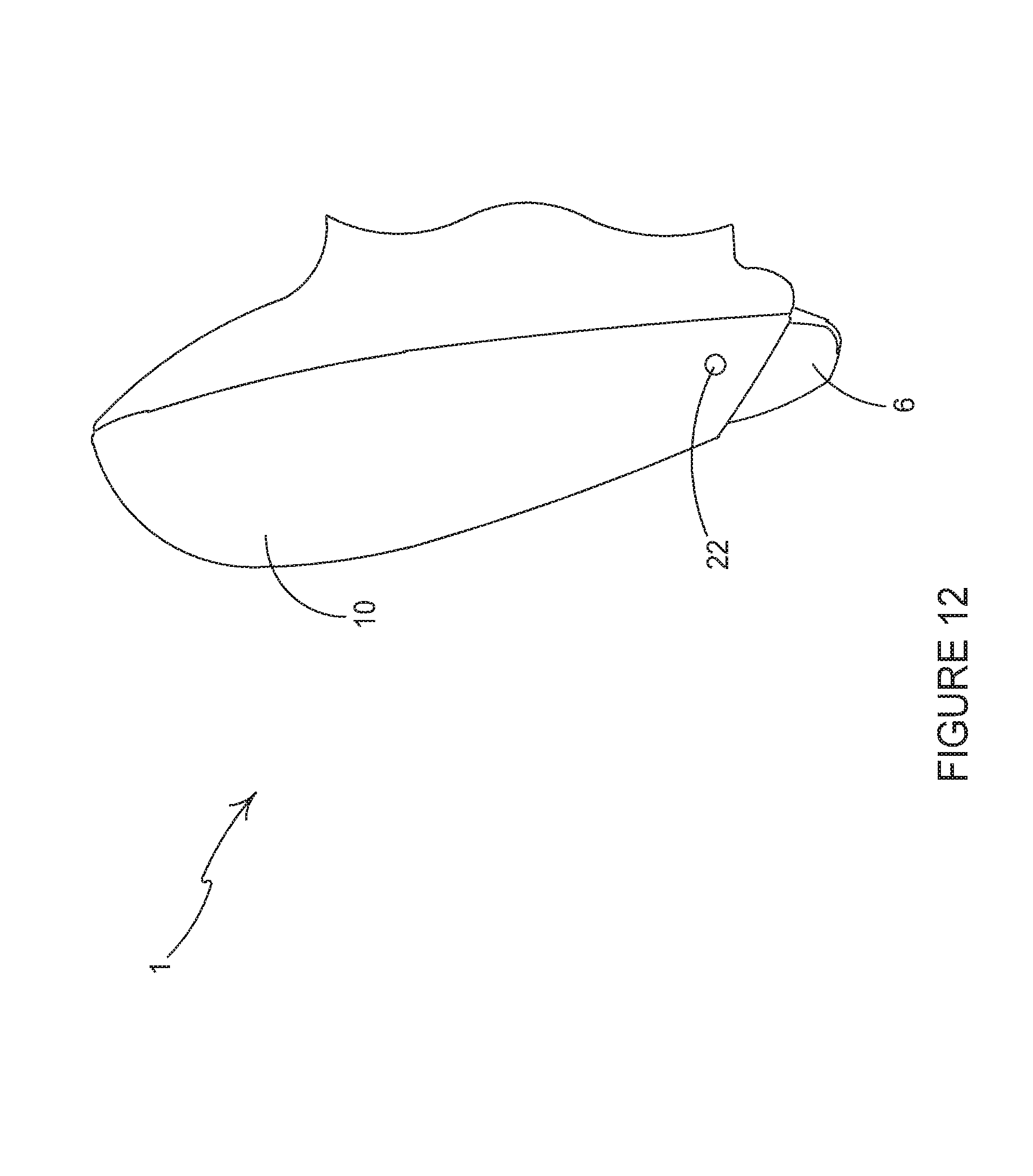
XML
uspto.report is an independent third-party trademark research tool that is not affiliated, endorsed, or sponsored by the United States Patent and Trademark Office (USPTO) or any other governmental organization. The information provided by uspto.report is based on publicly available data at the time of writing and is intended for informational purposes only.
While we strive to provide accurate and up-to-date information, we do not guarantee the accuracy, completeness, reliability, or suitability of the information displayed on this site. The use of this site is at your own risk. Any reliance you place on such information is therefore strictly at your own risk.
All official trademark data, including owner information, should be verified by visiting the official USPTO website at www.uspto.gov. This site is not intended to replace professional legal advice and should not be used as a substitute for consulting with a legal professional who is knowledgeable about trademark law.